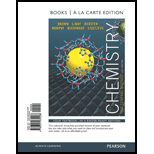
(a)
To determine:
The experiments that would allow the identification of the given substances.
(a)
Answer to Problem 1DE
Solution:
The given substances can be identified by reaction with lewis acid and lewis base.
Explanation of Solution
Samples of five substances are given. The substances are
The given substances can be identified by reaction with lewis acid and lewis base.
(b)
To determine:
The procedure for identification if data from internet is available.
(b)
Answer to Problem 1DE
Solution:
The given substances can be identified by their melting points.
Explanation of Solution
Samples of five substances are given. The substances are
These substances have different melting points. Therefore, they can be identified with the help of their melting points.
The given substances can be identified by their melting points.
(c)
To determine:
The substance that could undergo reaction to add more atoms around the central atom.
(c)
Answer to Problem 1DE
Solution:
The substances that could undergo reaction to add more atoms around the central atom are
Explanation of Solution
Among the given compounds,
The substances that could undergo reaction to add more atoms around the central atom are
(d)
To determine:
The substance which is likely to be solid.
(d)
Answer to Problem 1DE
Solution:
The substance which is likely to be solid is
Explanation of Solution
Among the given substances,
The substance which is likely to be solid is
Want to see more full solutions like this?
Chapter 22 Solutions
Chemistry: The Central Science, Books a la Carte Plus MasteringChemistry with eText -- Access Card Package (13th Edition)
 ChemistryChemistryISBN:9781305957404Author:Steven S. Zumdahl, Susan A. Zumdahl, Donald J. DeCostePublisher:Cengage Learning
ChemistryChemistryISBN:9781305957404Author:Steven S. Zumdahl, Susan A. Zumdahl, Donald J. DeCostePublisher:Cengage Learning ChemistryChemistryISBN:9781259911156Author:Raymond Chang Dr., Jason Overby ProfessorPublisher:McGraw-Hill Education
ChemistryChemistryISBN:9781259911156Author:Raymond Chang Dr., Jason Overby ProfessorPublisher:McGraw-Hill Education Principles of Instrumental AnalysisChemistryISBN:9781305577213Author:Douglas A. Skoog, F. James Holler, Stanley R. CrouchPublisher:Cengage Learning
Principles of Instrumental AnalysisChemistryISBN:9781305577213Author:Douglas A. Skoog, F. James Holler, Stanley R. CrouchPublisher:Cengage Learning Organic ChemistryChemistryISBN:9780078021558Author:Janice Gorzynski Smith Dr.Publisher:McGraw-Hill Education
Organic ChemistryChemistryISBN:9780078021558Author:Janice Gorzynski Smith Dr.Publisher:McGraw-Hill Education Chemistry: Principles and ReactionsChemistryISBN:9781305079373Author:William L. Masterton, Cecile N. HurleyPublisher:Cengage Learning
Chemistry: Principles and ReactionsChemistryISBN:9781305079373Author:William L. Masterton, Cecile N. HurleyPublisher:Cengage Learning Elementary Principles of Chemical Processes, Bind...ChemistryISBN:9781118431221Author:Richard M. Felder, Ronald W. Rousseau, Lisa G. BullardPublisher:WILEY
Elementary Principles of Chemical Processes, Bind...ChemistryISBN:9781118431221Author:Richard M. Felder, Ronald W. Rousseau, Lisa G. BullardPublisher:WILEY





